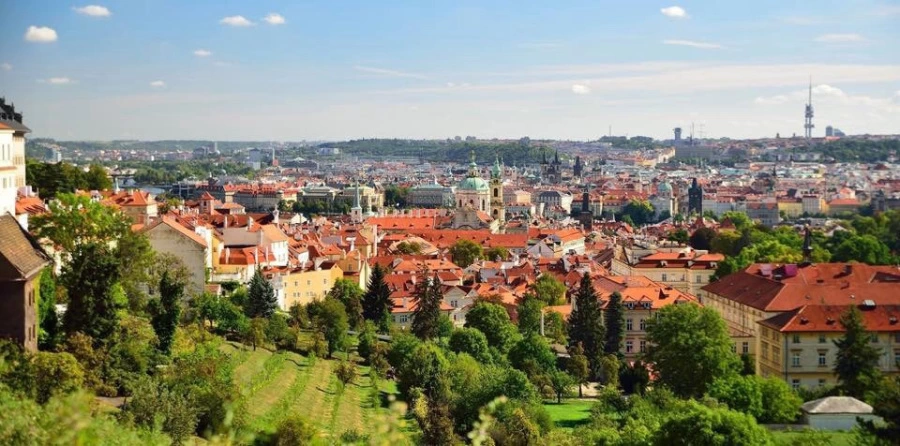
The Prague Astronomical clock is a unique medieval monument . It was built under Charles , Bohemian King, who transformed Prague in to a European center of learning, Culture and Power. The Old town astronomical clock was built as one of the last medieval archaic astronomical clocks.
The clock mechanism itself has three main components: the astronomical dial, representing the position of the Sun and the Moon in the sky and displaying various astronomical details; statues of various Catholic saints stand on either side of the clock
The background represents the Earth and the local view of the sky. The blue circle directly in the centre represents the Earth, and the upper blue is the portion of the sky which is above the horizon. The red and black areas indicate portions of the sky below the horizon. During the daytime, the Sun sits over the blue part of the background and at night it sits over the black. During dawn or dusk, the mechanical sun is positioned over the red part of the background.
Written on the eastern (left) part of the horizon is aurora (dawn in Latin) and ortus (rising). On the western (right) part is occasus (sunset), and crepusculum (twilight).
Golden Roman numerals at the outer edge of blue circle are the timescale of a normal 24-hour day and indicate time in local Prague time, or Central European Time. Curved golden lines dividing the blue part of dial into 12 parts are marks for unequal "hours". These hours are defined as 1/12 of the time between sunrise and sunset, and vary as the days grow longer or shorter during the year.
At the outer edge of the clock, golden Schwabacher numerals are set on a black background. These numbers indicate Old Czech Time, with 24 indicating the time of sunset, which varies during the year from as early as 16:00 in winter to 20:16 in summer. This ring moves back and forth during the year to coincide with the time of sunset.
Sun -
The golden Sun moves around the zodiacal circle, thus showing its position on the ecliptic. The Sun is attached to an arm with a golden hand, and together they show the time in three different ways:
The position of the golden hand over the Roman numerals on the background indicates the time in local Prague time. The position of the Sun over the curved golden lines indicates the time in unequal hours. The position of the golden hand over the outer ring indicates the hours passed after sunset in Old Czech Time.
Additionally, the distance of the Sun from the center of the dial shows the time of sunrise and sunset. The Sun and its hand are on the 365-tooth gear inside the machine.
Moon -
The movement of the Moon on the ecliptic is shown similarly to that of the Sun, although the speed is much faster, due to the Moon's orbit around the Earth. The Moon's arm is on the 379-tooth gear inside the clock machine.
The half-silvered, half-black sphere of the moon also shows the Lunar phase. The Moon has a 57-tooth gear inside its sphere, and is slowly rotated by a screw-thread attached to a weight, advancing two teeth per day. This movement, powered only by gravity, makes the Orloj unique in the world among astronomical clocks showing the phases of the Moon. The mechanism was created by an unknown maker, probably in the mid-17th century. Unlike the original device, the construction of which was described in a report from 1570, this mechanism produces much smaller deviation from the actual lunar phase of about one day in five years
Animated Figures -
The four figures flanking the clock are set in motion on the hour, and represent four things that were despised at the time of the clock's making. From left to right in the photographs, the first is Vanity, represented by a figure admiring himself in a mirror. Next, the miser holding a bag of gold represents greed or usury. Across the clock stands Death, a skeleton that strikes the time upon the hour. Finally, there is a Turkish figure representing lust and earthly pleasures. On the hour, the skeleton rings the bell and immediately all other figures shake their heads side to side, signifying their unreadiness "to go".
The Walk of the Apostles", a clockwork hourly show of figures of the Apostles and other moving sculptures - notably a figure of Death (represented by a skeleton) striking the time; and a calendar dial with medallions representing the months. According to local legend, the city will suffer if the clock is neglected and its good operation is placed in jeopardy; a ghost mounted on the clock was supposed to nod its head in confirmation. According to the legend the only hope was represented by a boy born on New Year's night.
Every hour of the day, twelve statues of Apostles with its attributes appear at the doorways above the clock. The left and right windows above the astronomical clock slide aside to reveal the Apostles as viewed from the square in this order: James and Peter, Andrew and Matthias, Thaddeus and Philip, Thomas and Paul, John and Simon, Barnabas and Bartholomew.
Calender -
The calendar plate below the clock was replaced by a copy in 1880. The original made by Josef Mánes is stored in the Prague City Museum. On the edge of the circle is a church calendar with fixed holidays and the names of 365 saints. The board displays allegories of the months. Smaller images represent zodiac signs.

Please feel free to share your Views / like & leave your comments on this blog in the comments section
©mytravelcsp . All rights reserved.
































